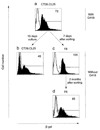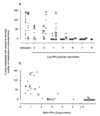Intensity of the vaccine-elicited immune response determines tumor clearance
- PMID: 11751979
- PMCID: PMC2259233
- DOI: 10.4049/jimmunol.168.1.338
Intensity of the vaccine-elicited immune response determines tumor clearance
Abstract
Tumor Ag-specific vaccines used for cancer immunotherapy can generate specific CD8 responses detectable in PBMCs and in tumor-infiltrating lymphocytes. However, human studies have shown that detection of a systemic vaccine-induced response does not necessarily correlate with the occasional instances of tumor rejection. Because this discrepancy might partially be attributable to the genetic heterogeneity of human cancers, as well as to the immunosuppressive effects of previous treatments, we turned to a mouse model in which these variables could be controlled to determine whether a relationship exists between the strength of vaccine-induced immune responses and tumor rejection. We challenged mice with the beta-galactosidase (beta-gal)-expressing tumor cells, C25.F6, vaccinated them with beta-gal-carrying viral vectors, and used quantitative RT-PCR to measure the vaccine-induced immune response of splenocytes directly ex vivo. We found that the strength of the response increased with increasing doses of beta-gal-carrying vector and/or upon boosting with a heterologous beta-gal-carrying virus. Most importantly, we found that the strength of the detected immune response against this foreign Ag strongly correlated with reduction in the number of lung metastases. The results from this mouse model have major implications for the implementation of tumor vaccines in humans.
Figures






Similar articles
-
Tumor growth inhibition elicited by different vaccines and correlation with antigen specific cytotoxic T-cell frequencies determined by intracellular interferon-gamma staining.Cancer Lett. 2002 Nov 8;185(1):53-9. doi: 10.1016/s0304-3835(02)00321-x. Cancer Lett. 2002. PMID: 12142079
-
Highly attenuated modified vaccinia virus Ankara (MVA) as an effective recombinant vector: a murine tumor model.Vaccine. 1997 Mar;15(4):387-94. doi: 10.1016/s0264-410x(96)00195-8. Vaccine. 1997. PMID: 9141209 Free PMC article.
-
Influence of gene-modified (IL-7, IL-4, and B7) tumor cell vaccines on tumor antigen presentation.J Immunol. 1997 Mar 15;158(6):2834-41. J Immunol. 1997. PMID: 9058819
-
The boosting effect of co-transduction with cytokine genes on cancer vaccine therapy using genetically modified dendritic cells expressing tumor-associated antigen.Int J Oncol. 2006 Apr;28(4):947-53. Int J Oncol. 2006. PMID: 16525645
-
Correlates of immune and clinical activity of novel cancer vaccines.Semin Immunol. 2018 Oct;39:119-136. doi: 10.1016/j.smim.2018.04.001. Epub 2018 Apr 27. Semin Immunol. 2018. PMID: 29709421 Review.
Cited by
-
CTLA-4 blockade augments human T lymphocyte-mediated suppression of lung tumor xenografts in SCID mice.Cancer Immunol Immunother. 2005 Oct;54(10):944-52. doi: 10.1007/s00262-005-0668-3. Epub 2005 Apr 22. Cancer Immunol Immunother. 2005. PMID: 15846492 Free PMC article.
-
Improved Anti-Tumour Adaptive Immunity Can Overcome the Melanoma Immunosuppressive Tumour Microenvironment.Cancers (Basel). 2019 Oct 31;11(11):1694. doi: 10.3390/cancers11111694. Cancers (Basel). 2019. PMID: 31683642 Free PMC article.
-
Lentivector immunization stimulates potent CD8 T cell responses against melanoma self-antigen tyrosinase-related protein 1 and generates antitumor immunity in mice.J Immunol. 2009 May 15;182(10):5960-9. doi: 10.4049/jimmunol.0900008. J Immunol. 2009. PMID: 19414747 Free PMC article.
-
Tumour-induced polarization of tumour vaccine-draining lymph node T cells to a type 1 cytokine profile predicts inherent strong immunogenicity of the tumour and correlates with therapeutic efficacy in adoptive transfer studies.Immunology. 2003 Mar;108(3):409-19. doi: 10.1046/j.1365-2567.2003.01596.x. Immunology. 2003. PMID: 12603608 Free PMC article.
-
Monitoring of vaccine-specific gamma interferon induction in genital mucosa of mice by real-time reverse transcription-PCR.Clin Vaccine Immunol. 2008 May;15(5):757-64. doi: 10.1128/CVI.00392-07. Epub 2008 Mar 26. Clin Vaccine Immunol. 2008. PMID: 18367582 Free PMC article.
References
Publication types
MeSH terms
Substances
Grants and funding
LinkOut - more resources
Full Text Sources
Other Literature Sources
Research Materials

